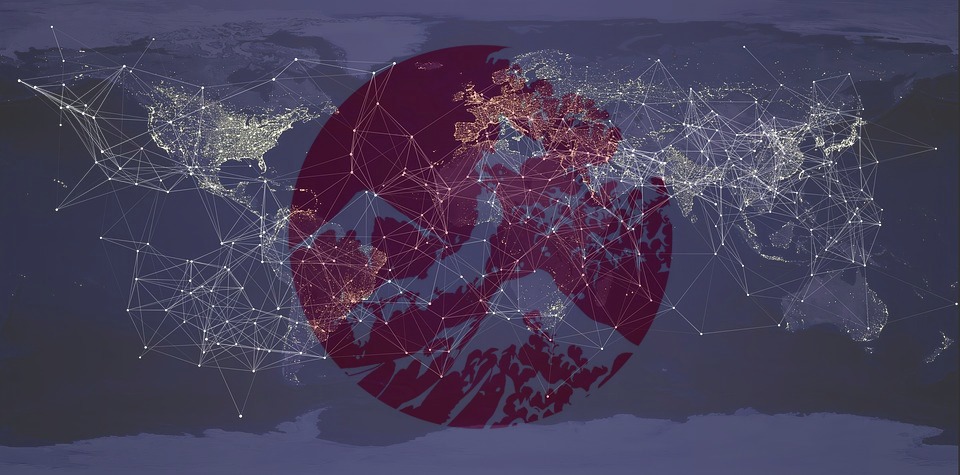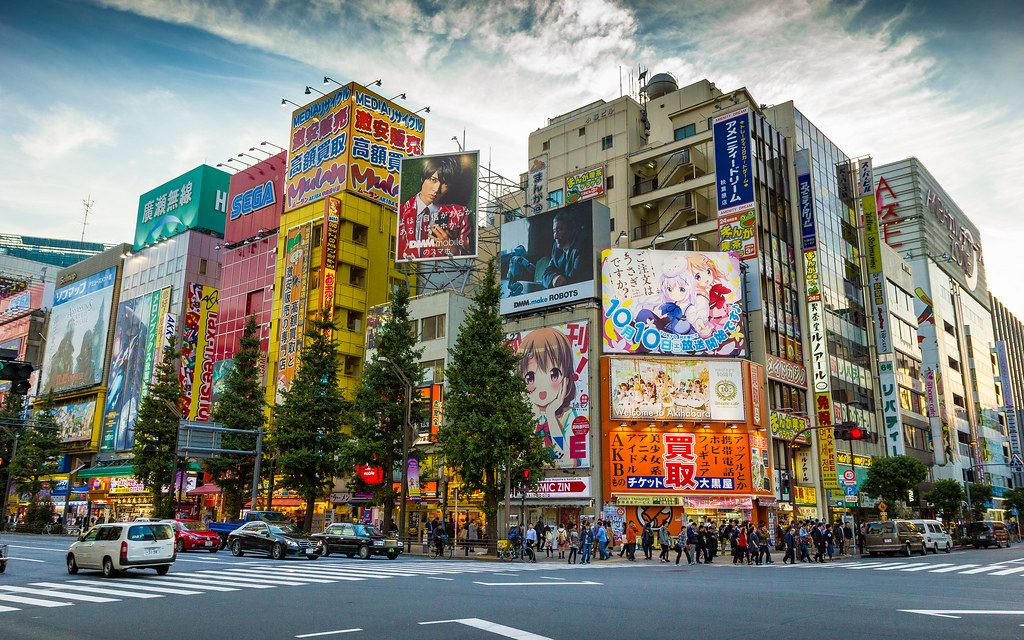
Japanese Pop Culture: A Global Phenomenon
The evolution of mass media in the late 20th century that goes hand in hand with the economic, political recovery and growth of post war Japan 1, helped the country in expanding its influence to a scale as big as it is today. The popular culture of Japan can be seen as a globally felt phenomenon. It’s an ever changing wave that influenced people’s lives throughout the world before and will continue to do so for decennia to come.
This project is realized by students participating in the course Working with popular culture. Several groups take on a topic within the theme of cultural globalisation. Globalisation is something that goes beyond just culture but in this edition of the magazine, there will only be a focus on mainly modern aspects of Japanese popular culture. But first, what do we understand by 'popular culture' and the globalisation it actually entails?
Globalisation, nani?
Globalisation refers to all those processes by which the peoples of the world are incorporated into a single world society, global society.
-- Martin Albrow, 1990
Globalisation is a multifaceted phenomenon involving people, companies and governments worldwide. The most influential aspects are politics and international economy, but its influences go further to the world's’ environment and international human rights. Globalisation involves every possible aspect of a nation on an international level.2 An evident positive outcome of globalisation would be improvements in developing countries by the investments of more developed countries. But a big con is how many developed countries are turning to the underdeveloped countries for cheaper workforce.3
The history of globalisation is as old as mankind; from the very start of people migrating from Africa to other parts of the world. By travelling migrants exchanged ideas, customs and products to new territories.4 A more concrete example would be the famed Silk Road (ca.130 BCE-1453 CE) that connected the East and West and as its name suggests, became known for trading Chinese silk but also spices, grains, vegetables, in short: everything you could trade. In our case, globalisation refers to the cultural aspect where certain cultures go beyond their nations. For example, Cannes Film Festival which previews new films from all around the world. The main purpose of the festival is to draw attention to and raise the profile of films, with the aim of contributing towards the development of cinema, boosting the film industry worldwide and celebrating cinema at an international level.
If we were to look at how the hereinabove defined term globalisation is applicable on Japan’s popular culture, we would have to look at certain aspects of the Japanese culture, mainly media such as anime, manga, fashion, etc. that have spread to and have their influence on the rest of the world. An example of this is the kawaii-culture, with franchises and products featuring the cute ‘Hello Kitty’, being known to relatively everyone.5|6
Phenomena like these were key to giving Japan a huge popularity boost after their recovery from WW2, and are still ongoing nowadays, spreading the popularity of Japanese culture to the edges of the globe. This spread of the Japanese popular culture is especially present in the case of Asia -with a population of around 3 billion people-, where since the 1990s, these countries were becoming more powerful economic-wise. Thus having more economic potential, this naturally lead to different markets being more receptive to Japanese popular culture, bringing about a circulation on a larger scale.7
It is also important to understand that the spread of the Japanese popular culture is not necessarily the effect of a certain economic or political discourse. Rather, the factors that ameliorate this fast spread of Japanese popular culture are individuals like you and myself, who contribute more to the transnational transmission of popular culture than one would initially think. A solid example is found when looking at Hong Kong and Mainland China of the latter half of the 1990s. There the main pushing factor for the rapid spread of products, such as illegal compact disks that contain Japanese television programs, are the people on the receiving end of the products, i.e. not the original Japanese creators. Thus we have a transport of certain objects of popular culture of which the pushing factor is not the country of origin itself (signifying that the products were neither commercialised in the receiving country, nor that any clear effort was made by Japan to distribute them from an economic perspective), but rather a country in which there is an interest for Japanese popular culture.8
Popular culture and Japan

According to KU Leuven professor Jan Baetens, in order for something to be labeled as popular culture, it has to fulfill the three main criteria:
- Something where media (or at least one medium) are involved.
- Something supported by an industrial production system.
- Something that was only created after the start of the 19th century, anything older is an anachronism.
It is also important to note that the reason why something becomes a popular phenomenon is not only because of the creator, but also thanks to the (re)usage or adaptation of it, without consumers something can never become popular culture. In today’s society where the entire world is connected through i.a. the internet, popular culture often becomes a global phenomenon. Seeing it can be shared through a variety of media and therefore reach a humongous public.
The general academic world was initially very hesitant to include popular culture in their research and often disregarded its importance and relevance9. The innate tendency to always refer to the Western culture as a standard caused many academics to take a very sceptical stance on making use of popular culture. Even though many were against it, other scholars strived to use a more elaborate take on humanities and thus also include popular culture in order to have more diverse and inclusive research. It is seen as an important topic to investigate seeing it provides knowledge of the current interests and priorities in today’s society. Many universities have finally come to acknowledge how popular culture affects many in their daily life and more courses are being taught on this particular topic.
Japanese popular culture10 is not necessarily anything that is ‘essentially’ or ‘authentically’ Japanese. It is more like a study of information flows that are associated with Japan. Japanese popular culture is known for manga, J-POP, anime, TV dramas, etc. These can be used to create one’s own identity, one can see themselves reflected on screen or paper and feel connected with the characters. Therefore, many become intensely invested in the characters appearing. Another reason why several Japanese phenomena became so popular and globally known is because of how well current problems are portrayed and thus feel like personal concerns to the consumer.
Japan now contributes not just to our material lives, but to our everyday cultural lives as well.
-- Timothy J. Craig, 2000
During the postwar period Japan was seen in two ways by the outside world: an exotic land with samurai and Zen Buddhism; powerful military and later economically nation.11 As to Japan’s pop culture, it was rather successful domestically and had little to none achievement abroad. But if we take a look at today's pop culture, we can see that Japanese popular culture has gained lots of attention internationally. To give some examples: the new generations grew up watching anime instead of Western cartoons like Mickey Mouse. Terms like karaoke and manga have become part of the international lexicon and popular Japanese trends even have an influence on Western fashion and graphic design.
Articles
Aside from this introductory article, there are five articles that will elaborate on a certain aspect of the Popular Culture of Japan. The different group members will be listed down below.
The first group will focus on Fashion. They have created a questionnaire concerning different fashion trends, designs, and esthetic concepts of Japan. The second group has conducted a comparative study of the horror movies of Japan and America, including stereotypes and genres that can be found within. The third group has compared beauty standards between Japan, Korea, and America, with a main focus on the different trends in makeup. The fourth group discusses the legal grey areas concerning prostitution in Japan, looking closely at some of the laws concerning this topic. The last group has analysed the importance of dialects in language within manga by using OCR (Optical Character Recognition), a technology that allows for the conversion of text in an image to digital text.
Groups
- Editorial Group: Anna Ishizawa-Keignaert, Brent De hornois, Hanne Vermeiren, Naomi Leelasirivorranon, Siebe Goris, Kasper Rubens
- Fashion: Hannah Patteet, Ilja Blondeel, Anthe Herweyers, Elin Mariën, Zhina Abdellah, Floor Vaartjes, Ella Van Aken
- Horror: Natasha Hoogervorst, Rowan Rongé, Lucas Thirion, Patryck Piekarz, Rani Aertsgeerts, Caroline Mennens, Lieze van Meerbeek
- Beauty Standards: Gladys Coenen, Sofie van Riel, Evelien Meijers, Philip Grabowski, Tsenguunbolor Sels
- Sex Industry: Jesse Holvoet, Diederik Wéreau, Adam Zuidam, Jordy De Leender, Arthur Leroy, Arvit Maes
- Manga OCR: Dilhan Ismail, Antoine Reginster, Bjorn Smeets, Liesl Seyen, Annick Daelemans, Hannelore Kiekens
Acknowledgements
We would like to especially thank Hans Coppens for guiding us throughout the classes. Special thanks also to Jan Baetens, for helping us defining what popular culture is, and Nele Noppe (@unjapanologist) and Stevie Poppe (@PoppeStevie) for their talks on practical Japanese popular culture research. The main inspiration for this magazine came from Mechademia, an annual peer-reviewed academic journal of Japanese popular culture.
-
IWASAKI, I., Japanese Economic Foundation, https://www.jef.or.jp/journal/pdf/157cover01+.pdf (visited on 19/05/2019) ↩
-
Levin Institute, http://www.globalization101.org/what-is-globalization, (visited on 7 May 2019) ↩
-
Fobes, http://www.forbes.com/sites/mikecollins/2015/05/06/the-pros-and-cons-of-globalization/#25fbde1eccce, (visited on 7 May 2019) ↩
-
Yale Global, http://www.yaleglobal.yale.edu/about-globalization, (visited on 14 May 2019) ↩
-
Allen, M., & Sakamoto, R. (Eds.). (2007). Popular culture, globalization and Japan. Routledge. ↩
-
Allen, Matthew, and Sakamoto, Rumi (2014) Globalizing Japanese Popular Culture: the coolness of Japan? Japanese Popular Culture: critical concepts in Asian studies, 4 . Routledge, London, UK. ↩
-
Iwabuchi, K. (2002). Recentering globalization: Popular culture and Japanese transnationalism. Duke University Press. ↩
-
Nakano, Yoshiko. “Who Initiates a Global Flow? Japanese Popular Culture in Asia.” Visual Communication, vol. 1, no. 2, 2002, pp. 229–253. ↩
-
LARABEE A. (2018), The Bowling Green Method in Popular Culture Studies. The Journal of Popular Culture Studies, 51 (3), pp.573-574 ↩
-
FREEDMAN A. (2018), Introducing Japanese popular culture. London: Routledge Taylor & Francis Group ↩
-
CRAIG T.J. (2000), Japan Pop!: Inside the World of Japanese Popular Culture, pp.4-5 ↩